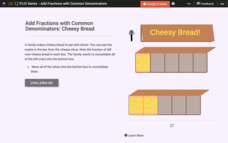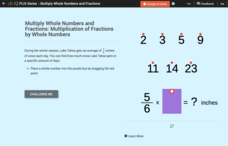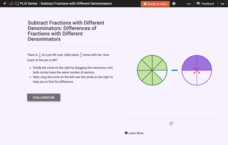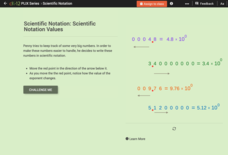CK-12 Foundation
Properties of Multiplication in Decimal Operations: Balloon Animals
Commutive and associative properties are the focus of a five-question interactive. Dealing with decimal multiplication and addition, mathematicians solve multiple-choice and true or false questions using a model that moves balloons along...
CK-12 Foundation
Sums of Fractions with Like Denominators: Cheesy Bread
Five questions make up an interactive all about adding fractions with like denominators. Mathematicians answer multiple-choice problems and an open-ended question using a fraction model that resembles sliced bread. The practice ends with...
CK-12 Foundation
Subtraction of Fractions: Fragmented Fractions
An interactive challenges scholars to subtract mixed numbers. Pupils answer questions—multiple-choice, fill in the blank, and true or false—with help from virtual fraction strips. The practice closes with a discussion.
CK-12 Foundation
Multiplication of Whole Numbers by Fractions: Multiplication of Fractions by Whole Numbers
An interactive challenges mathematicians to multiply fractions by whole numbers. A model provides a clear visual aid in preparing whole numbers to be multiplied. Six questions include multiple-choice, fill in the blank, short answer, and...
CK-12 Foundation
Differences of Fractions with Different Denominators
Subtracting fractions with unlike denominators is the focus of an interactive designed to boost mathematicians' problem-solving skills. Five questions challenge participants to answer multiple-choice and true or false questions with help...
CK-12 Foundation
Products of Two Fractions: Blocks
Five questions make up an interactive designed to boost the multiplication of fraction skills. An assortment of color-coded fraction blocks assists participants to find the right answer. Question types include multiple-choice and fill in...
CK-12 Foundation
Division of Fractions: Stacking Berets
Seven questions make up an interactive designed to boost mathematician's skills in dividing whole numbers by mixed fractions. Practice comes with a visual aid with movable parts. Questions types include fill in the blank,...
CK-12 Foundation
Repeating Decimals: Does 1 equal 0.999... ?
Six questions make up a challenging interactive that tests scholars' knowledge of repeating decimals. Mathematicians answer true or false and multiple-choice questions with help from a tool that highlights decimal movement in an...
CK-12 Foundation
Whole Number Exponents: Building Blocks
Five questions make up an interactive all about whole-number exponents. Movable building blocks create a visual tool to aide mathematicians in answering multiple-choice and true or false problems. The interactive ends with a discussion...
CK-12 Foundation
Scientific Notation Values
Scientific notation is the focus of a five-question interactive. A model with movable points offers a visual reference to help solve true or false, multiple-choice, and fill in the blank questions. A discussion question challenges...
CK-12 Foundation
Numbers with Decimal Place Value: Battleship Decimals
Decimal place value is the topic of a Battleship themed-interactive. Scholars answer five questions—multiple-choice and true or false—while referencing a grid that acts as the board game. The practice concludes with a discussion question.
Utah Education Network (UEN)
Utah Open Textbook: 8th Grade Science
The cycle of energy is important to many different systems on Earth. Scholars use questioning and observation to investigate the differences between renewable and non-renewable resources and how they relate to global changes. They...
Utah Education Network (UEN)
Utah Open Textbook: 7th Grade Science
Physical and biological factors affect everyday living. Scholars explore electromagnetic forces, motion, the rock cycle, and geological changes. They examine cells as the building blocks of life and how organisms reproduce using images...
CK-12 Foundation
And and Or Statements: Number Lines
Compound statements are actually quite simple. A virtual interactive provides a means to graph solution sets to compound statements involving and and or. Users then answer a few challenge questions on these solution sets.
CK-12 Foundation
Formulas for Problem Solving: Finding Distance, Rate, and Time
Go the distance in learning about distance, rate, and time. Young mathematicians use an interactive to investigate the relationship between distance, rate, and time. A set of challenge questions assesses understanding of these...
CK-12 Foundation
Mode: Kittens
It is not as difficult as herding cats. The short interactive provides a group of kittens to sort according to their colors. Pupils determine the mode of the number of kittens by color. The questions continue with other numbers of...
CK-12 Foundation
Mode: Mucho Money
Generate stacks of money. Given bills of different denominations, pupils stack them based on their values. The learners figure out which value is the mode of the data and determine whether the data is unimodal, bimodal, or multimodal.
CK-12 Foundation
Mode: Boxes of Oranges
See how your data stacks up. Pupils stack crates of oranges in increasing order, creating a simple bar graph. Using the graph, individuals determine measures of center and describe the shape of the distribution. Scholars determine what...
CK-12 Foundation
Mean: Harmonic Mean
Let the means live in harmony. With lengths representing the values of a small data set, learners compare the arithmetic mean to the harmonic mean. The pupils determine which value is the most accurate representation of the average of...
CK-12 Foundation
Mean: Arithmetic Mean
How is a mean affected by changes in data? A well-designed animation allows individuals to manipulate data and watch the effect on the mean. Challenge questions help guide users to conclusions about outliers and skew within data.
CK-12 Foundation
Introduction to Mean, Median, and Mode: The Tree Conundrum
How many trees should we plant? Using an interactive as a manipulative, individuals find the mean, median, and mode for sets of data. They determine the number of trees to plant in each plot of land to reach a statistical goal.
CK-12 Foundation
Simple Random Sampling: How Many Samples Does it Take to Change a Light Bulb?
Teach the concept of simple random sampling through an interactive lesson. Learners explore the concept by considering the strength of sampling methods. Size of the samples varies also as individuals determine which methods lead to the...
CK-12 Foundation
Two-Sided Stem-and-Lead Plots: Gamers
Which gender spends more time playing video games? Your classes use provided data to answer this question. They first build a two-sided stem-and-leaf plot and then use the display to look for patterns. Guiding questions help them...
CK-12 Foundation
Stem-and-Leaf Plots and Histograms: Digital Photography
Cameras use histograms to communicate the exposure of a photograph. An interesting lesson uses this idea to help learners deepen their understanding of histograms. It highlights the skew of the graphs by showing under- and overexposed...

























